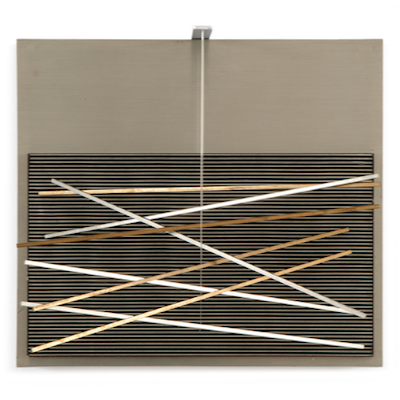
Details
Artist
Styles
Silkscreen print in colour. - Signed and numbered - Editor: Denise René, Paris // Victor Vasarely's Sorbonne, created in 1973, is a vibrant silkscreen print that exemplifies the artist’s pioneering work in the Op Art movement. The composition features a grid of colorful geometric shapes—circles, squares, triangles, and diamonds—arranged in a rhythmic pattern across a rich brown background. The shapes are rendered in striking hues of red, blue, green, yellow, purple, and black, creating an optical effect that draws the viewer’s eye across the grid. The orderly yet varied placement of forms generates a sense of depth and movement, typical of Vasarely’s exploration of visual perception and spatial illusions. Signed and numbered by the artist, this print was published by Denise René in Paris as part of an edition limited to 425. Sorbonne is a testament to Vasarely’s mastery of color and form, inviting viewers to experience the dynamic interplay of shapes and shades.
Sorbonne, 1973
form
Medium
Size
79.5 x 71.5 cm
- Inches
- Centimeters
Edition
Price
- USD
- EUR
- GBP
Details
Artist
Styles
Silkscreen print in colour. - Signed and numbered - Editor: Denise René, Paris // Victor Vasarely's Sorbonne, created in 1973, is a vibrant silkscreen print that exemplifies the artist’s pioneering work in the Op Art movement. The composition features a grid of colorful geometric shapes—circles, squares, triangles, and diamonds—arranged in a rhythmic pattern across a rich brown background. The shapes are rendered in striking hues of red, blue, green, yellow, purple, and black, creating an optical effect that draws the viewer’s eye across the grid. The orderly yet varied placement of forms generates a sense of depth and movement, typical of Vasarely’s exploration of visual perception and spatial illusions. Signed and numbered by the artist, this print was published by Denise René in Paris as part of an edition limited to 425. Sorbonne is a testament to Vasarely’s mastery of color and form, inviting viewers to experience the dynamic interplay of shapes and shades.
- Recently Added
- Price (low-high )
- Price (high-low )
- Year (low-high )
- Year (high-low )
What is kinetic art?
Kinetic art is an international movement that emerged in the 1920s and gained prominence in the 1960s, referring to art that involves both apparent and real motion. It encompasses any medium that includes movement, either relying on actual motion for its effect or being perceived as moving by the viewer. Early examples include canvas paintings designed to create optical illusions of movement. Today, kinetic art often refers to three-dimensional figures and sculptures, such as those operated by machines or those that move naturally. The movement covers a variety of styles and techniques that frequently overlap.






































































